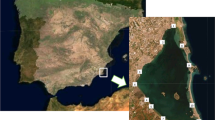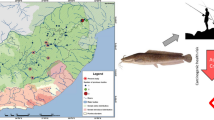Abstract
Trace element content of marine algae species collected from the Black Sea coasts were determined by atomic absorption spectroscopy after microwave digestion. Trace element content in marine algae species were 1.70–17.1 μg/g for copper, 3.64–64.8 μg/g for zinc, 9.98–285 μg/g for manganese, 99–3,949 μg/g for iron, 0.50–11.6 μg/g for chromium, 0.27–36.2 μg/g for nickel, 11–694 μg/kg for selenium, 0.50–44.6 μg/kg for cadmium, 1.54–3,969 μg/kg for lead, 1.56–81.9 μg/kg for cobalt. While iron was the highest trace element concentration, cadmium was the lowest in samples. Most of the analyzed samples were edible. The samples are consumed for human diet in several countries.
Similar content being viewed by others
References
Arain, S. I., Kazi, T. G., Bhanger, M. I., & Memon, A. N. (2006). Evaluation of the status of iron in different honey samples. Journal of the Chemical Society of Pakistan, 28, 448–450.
Arain, M. B., Kazi, T. G., Jamali, M. K., Jalbani, N., Afridi, H. I., & Baig, J. A. (2008). Speciation of heavy metals in sediment by conventional, ultrasound and microwave assisted single extraction: a comparison with modified Sequential extraction procedure. Journal of Hazardous Materials, in press.
Conti, M. E., & Cecchetti, G. (2003). A biomonitoring study: Trace metals in algae and mollusks from Tyrrhenian coastal areas. Environmental Research, 93, 99–112.
Csikkel-Szolnoki, A., Bathori, M., & Blunden, G. (2000). Determination of elements in algae by different atomic spectroscopic methods. Microchemical Journal, 67, 39–42.
FAO/WHO (1976). List of maximum levels recommended for contaminants by the Joint FAO/ WHO Codex Alimentarius Commission. (Vol. 3, pp. 1–8). Second Series. CAC/ FAL, Rome.
Food and Nutrition Board, Institute of Medicine (2000). Dietary reference intakes for Vitamin C, Vitamin E, selenium, and carotenoids. Washington, DC: The National Academies Press.
Ghaedi, M., Fathi, M. R., Marahel, F., & Ahmadi, F. (2005). Simultaneous preconcentration and determination of copper, nickel, cobalt and lead ions content by flame atomic absorption spectrometry. Fresenius Environmental Bulletin, 14, 1158–1163.
Ghaedi, M., Shokrollahi, A., Kianfar, A. H., Mirsadeghi, A. S., Pourfarokhi, A., & Soylak, M. (2008). The determination of some heavy metals in food samples by flame atomic absorption spectrometry after their separation-preconcentration on bis salicyl aldehyde, 1,3 propan diimine (BSPDI) loaded on activated carbon, Journal of Hazardous Materials, in Press.
Indegaard, M., & Minsaas, J. (1991). Animal and human nutrition. In M. D. Guiry, & G. Blunden (Eds.) Seaweed resources in Europe: uses and potential (pp. 21–64). Chichester: John Wiley & Sons Ltd.
Joint FAO/WHO (1999). Expert committee on food additives. Summary and conclusions, 53rd meeting, Rome, 1–10 June.
Korn, M. G. A., Morte, E. S. B., dos Santos, D. C. M. B., Castro, J. T., Barbosa, J. T. P., Teixeira, A. P., et al. (2008). Sample Preparation for the Determination of Metals in Food Samples Using Spectroanalytical Methods-A Review. Applied Spectroscopy Reviews, 43, 67–92.
Lynch, S. R., & Baynes, R. D. (1996). Deliberations and evaluations of the approaches, endpoints and paradigms for iron dietary recommendations. American Institute of Nutrition, 126, 2404S–2409S.
Madejczyk, M.,& Baralkiewicz, D. (2008). Characterization of Polish rape and honeydew honey according to their mineral contents using ICP-MS and FAAS, Analytica Chimica Acta, in press.
National Academy of Sciences (1980). Recommended Dietary Allowances, 9th edn. Washington: NAS.
Rao, C. R. M., Sahuquillo, A. & Lopez Sanchez, J. F. (2008). A Review of the different methods applied in environmental geochemistry for single and sequential extraction of trace elements in soils and related materials. Water Air Soil and Pollution, 189, 291–333.
RDA (1989). Recommended Dietary Allowance, 10th edn. Washington, DC: National Academic Press.
Ruperez, P. (2002). Mineral content of edible marine seaweeds. Food Chemistry, 79, 23–26.
Sawidis, T., Brown, M. T., Zachariadis, G., & Sratis, I. (2001). Trace metal concentrations in marine macroalgae from different biotopes in the Aegean Sea. Environment International, 27, 43–47.
Topcuoglu, S., Guven, K. C., Balkis, N., & Kirbasoglu, C. (2003). Heavy metal monitoring of marine algae from the Turkish coast of the Black Sea, 1998–2000. Chemosphere, 52, 1683–1688.
Tuzen, M. (2002). Determination of trace metals in sea lettuce (Ulva lactuca) by atomic absorption spectrometry. Fresenius Environmental Bulletin, 11(7), 405–409.
Tuzen, M. (2003). Determination of heavy metals in fish samples of the middle Black Sea (Turkey) by graphite furnace atomic absorption spectrometry. Food Chemistry, 80, 119–123.
Uluozlu, O. D., Tuzen, M., Mendil, D., & Soylak, M. (2007). Trace metal content in nine species of fish from the Black and Aegean Seas, Turkey. Food Chemistry, 104, 835–840.
van Netten, C., Hoption Cann, S. A., Morley, D. R., & van Netten, J. P. (2000). Elemental and radioactive analysis of commercially available seaweed. The Science of the Total Environment, 255, 169–175.
Villares, R., Puente, X., & Carballeira, A. (2002). Seasonal variation and background levels of heavy metals in two green seaweeds. Environment International, 119, 79–90.
World Health Organization (1994). Quality directive of potable water, WHO 2 nd ed., 197.
Author information
Authors and Affiliations
Corresponding author
Rights and permissions
About this article
Cite this article
Tuzen, M., Verep, B., Ogretmen, A.O. et al. Trace element content in marine algae species from the Black Sea, Turkey. Environ Monit Assess 151, 363–368 (2009). https://doi.org/10.1007/s10661-008-0277-7
Received:
Accepted:
Published:
Issue Date:
DOI: https://doi.org/10.1007/s10661-008-0277-7




